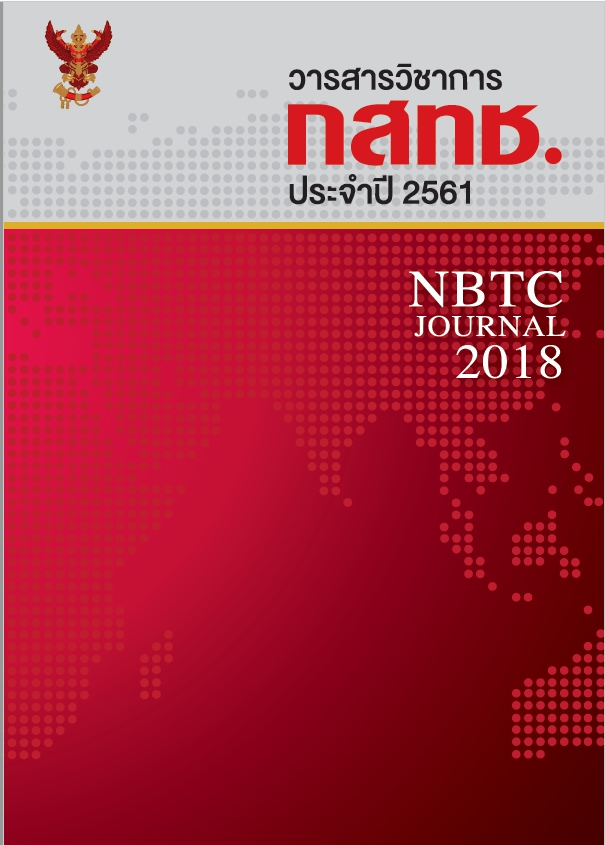Research and Development of a Near Real-time Captioning Service
Main Article Content
Abstract
To broadcasting a live television program with a real-time closed captioning service, two sub-systems must be added to the existing broadcasting system: 1) a real-time speech transcribing module and 2) a live stream text receiving module. In this study, the technique called simulated-typing developed by National Electronics and Computer Technology Center (NECTEC) is used to produce real-time transcription for Thai. The PIMmala subtitle gateway and VT3 PEACH DVB-sub generator together are then used to produce closed captioning service from a live text stream in DVB-T2 format. From five technical experiments and two user experiments, it has been shown that the television broadcasting systems developed under this study can produce and broadcast a real-time closed captioning service that is acceptable by people with hearing disability which is the targeted group of this study. The captioning accuracies of live news programs are around 80-90%. In terms of delay, the caption appears on a television screen within 6.6 seconds after the corresponding speech. Due to bandwidth limitation, which the regulator allocated only 100 kpbs for the closed caption service, the caption has to be displayed in block of characters every 500 milliseconds which increases the delay.
Article Details
เนื้อหาหรือบทความที่ปรากฏในวารสารวิชาการ กสทช. เป็นลิขสิทธิ์ของสำนักงานคณะกรรมการกิจการกระจายเสียง กิจการโทรทัศน์ และกิจการโทรคมนาคมแห่งชาติ
(สำนักงาน กสทช.) ซึ่งสำนักงาน กสทช. ขอสงวนสิทธิ์มิให้นำเนื้อหา ข้อความ หรือบทความไม่ว่าทั้งหมดหรือส่วนหนึ่งส่วนใดไปเผยแพร่ คัดลอก หรือตีพิมพ์ซ้ำโดยเด็ดขาด
เว้นแต่ได้รับอนุญาตเป็นลายลักษณ์อักษร ทั้งนี้ ข้อความ หรือความคิดเห็นที่ปรากฏในบทความแต่ละเรื่องที่ตีพิมพ์ในวารสารนี้ เป็นความคิดเห็นของผู้เขียน
ไม่ผูกพันต่อคณะกรรมการกิจการกระจายเสียง กิจการโทรทัศน์ และกิจการโทรคมนาคมแห่งชาติ (กสทช.) และสำนักงาน กสทช. รวมทั้งกรณีหากมี
การละเมิดสิทธิ์ถือเป็นความรับผิดชอบของผู้เขียนโดยตรงไม่เกี่ยวข้องกับสำนักงาน กสทช. แต่ประการใด
References
สำนักงานคณะกรรมการกิจการกระจายเสียง กิจการโทรทัศน์ และกิจการโทรคมนาคม, 2560, แนวปฏิบัติทางเทคนิคสำหรับการให้
บริการโทรทัศน์ภาคพื้นดินในระบบดิจิตอล (Technical Guidelines for Digital Terrestrial Television Broadcasting).
กรุงเทพมหานคร. น. 15, 36.
ห้างหุ้นส่วนจำกัด นีว่า เทคโนโลยี. (2560). คำป้อน Subtitle. น. 1-2. (ออนไลน์). สืบค้นจาก
https://www.nivatech.co.th/download/Kumpon-Subtitle.pdf
Chunwijitra, V., Chotimongkol, V., and Wutiwiwatchai, C., (2015)., Combining multiple-type input units using
recurrent neural network for LVCSR language modeling. Proceedings of Interspeech 2015, Germany, 16, 2385-
Mozilla. (2018, February 3). Introduction to WebRTC protocols. Retrieved from https://developer.mozilla.org/en-
US/docs/Web/API/WebRTC_API/Protocols

